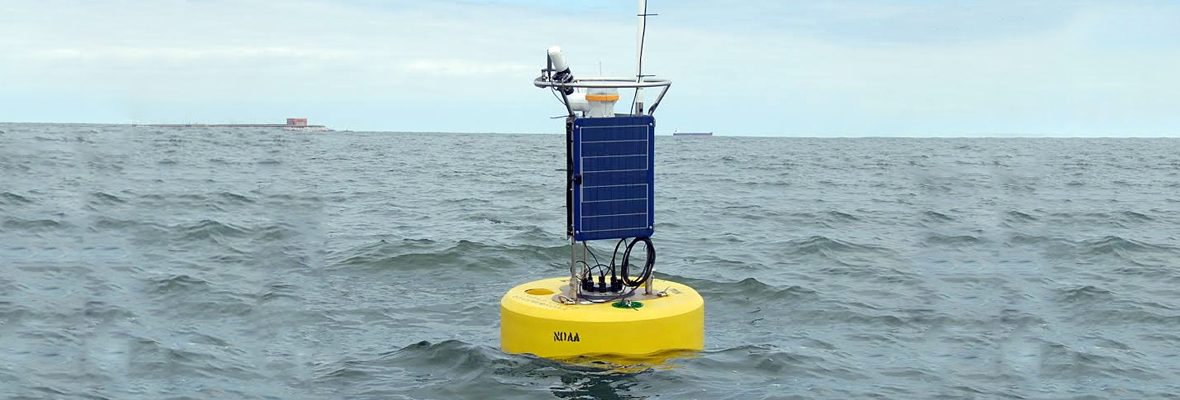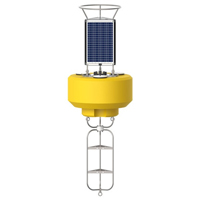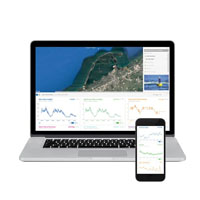Using data buoys to monitor water quality makes it easier to get ongoing, real-time data. This is the hard, empirical evidence that is essential to achieve well-supported, decisive policy-making action on environmental and public health issues. Monitoring water quality is increasingly challenging given the sheer number of compounds we now use in manufacturing, commerce, and our everyday lives. These compounds end up in our soil and water.
In this post, we’ll provide an overview of water monitoring buoys, explain the benefits of monitoring water quality using a buoy, and describe optimal data buoys for monitoring water quality.
An Overview of Water Monitoring Buoys
Buoy-based profiling tools for monitoring water quality and conducting research are reliable, simple to use, high-performing, and accurate. These data buoys are designed to be lightweight enough to make deployment easy, yet stable—so the buoys can keep functioning and providing good data despite high winds and other inclement weather.
Reliable, accurate data is the cornerstone of monitoring and research on water quality. Buoy-based water quality monitoring is often an optimal solution, given that research funds must be made to stretch as far as possible, even as water supplies being researched often become a community’s drinking water.
What does the typical buoy-based water quality monitoring station look like? In general, such a station will include a base or buoy platform; instruments for sensing, such as sondes, a temperature string, and other sensors; a data logger for collecting the information; mooring hardware and solar power to keep the unit running and stable; and telemetry equipment for sending the collected data on its way. Each platform can be customized to meet the application or project’s specific needs and budget.
Benefits of Monitoring Water Quality Using a Buoy
There are many benefits to a buoy-based water quality monitoring system. Here are some of the most important:
Flexibility. Both water monitoring buoy platforms and buoy sensors are completely customizable. Flexibility is baked into the design of these platforms, with the knowledge that users often need to modify or adapt their tools as their research questions and priorities for monitoring evolve. The same buoy-based water quality monitoring platform can house an individual sensor or more depending on the task at hand—which is why a data buoy is ideal for almost any kind of water quality application.
Independence. Data buoys don’t need constant attention—so you can stick with the rest of what you’re busy doing, most of the time. Backed up by battery and solar power options, buoys don’t need a source of AC power, making remote deployments possible. Buoy-based systems can also stay in touch with online systems and servers, thanks to various telemetry options for sensor control and remote data access. This means entire operational seasons with minimal demands for maintenance and without wasteful, annoying interruptions.
Real-time data. The difference between capturing an unusual event and missing it, or spotting a contaminant before it’s too late, is often in whether you’re collecting real-time data or not. Buoy-based water quality monitoring makes more frequent waterway sampling possible—as often as every minute. This means you’ve got high quality, consistent, streaming data in real time, 24 hours a day, 7 days a week, 365 days a year. This ongoing stream of data offers the chance to understand water conditions or engage in adaptive sampling in real-time.
Real-time access. Having the data hardly matters if it can’t be accessed. Using data buoys to monitor means that it’s easy to get a quick yet complete picture of what is happening with a drinking water supply. These systems also make it simple to quickly react when environmental conditions change or conduct adaptive sampling when conditions suggest it’s needed.
And real-time access doesn’t mean a lack of security. You can select data access controls that work for you, whether you want to keep the information private or foster awareness of water quality issues by sharing it with the public.
Data management tools are part of data buoy software. A data buoy is capable of transmitting reliable data as soon as it is powered up and deployed. You can also make use of online tools like the secure web datacenter, WQData and iChart software. These tools allow you to manage your data, access it easily, and execute various tasks for storing, graphing, and presenting your information.
These software packages and tools can also be set to alert your water manager’s smartphone or another device, so your response team knows as soon as the water quality parameters in question exceed certain thresholds. This takes the pressure off your team, eliminating the job of continuous data monitoring.
NexSens Buoys for Monitoring Water Quality
For offshore water quality monitoring, we recommend both the NexSens CB-150 and the NexSens CB-450 data buoys. Both models are specifically designed with floating platforms which support both subsurface and topside environmental monitoring sensors. These data buoys can also be equipped with cellular, spread spectrum radio, and satellite data transmission to shore.
The inner core of these NexSens data buoys, encased in tough polymer skin, are constructed of cross-linked polyethylene foam. To make deployment of subsurface instruments quicker, Three 4” pass-through holes with female NPT bottom threads allow for quick connection of instrument deployment pipes and custom sensor mounts. Further enabling quick deployment are lifting rigs and mooring lines supported by stainless steel eye-nuts mounted top and bottom.
To achieve continuous power, atop the buoys are 20” tall stainless steel towers with (3) 10-watt 12VDC solar panels mounted onto the tower. A central data well measuring 10” ID x 19.5” tall accommodates batteries, data loggers, sensors, and houses the charge regulator for solar power.
NexSens data buoys are designed to accommodate NexSens CB-series data loggers although a plate with pass-through fittings is optional for user-supplied electronics. If the latter, the top of the instrument well includes eight pass-through ports for power and sensor interface with each port offering an underwater receptacle with a double O-ring seal for a reliable waterproof connection. These ports allow you to connect industry-standard analog and digital sensor interfaces.
Using these data buoys, it’s simple and fast to deploy Doppler current meters, multi-parameter sondes, temperature strings, weather stations, and other monitoring instruments in lakes, reservoirs, rivers, streams and along the coast. Furthermore, NexSens data buoys offer you flexibility in terms of your instrumentation; while we typically use a YSI EXO sonde on the buoys to measure basic water quality parameters, our data loggers are compatible with most water quality sondes and sensors on the market, including Hydrolab, Eureka and others.
The Bottom Line
Buoy-based water quality monitoring tools for research and management are reliable, high-performing, simple to use, and accurate. These data buoys enable quick, easy deployment yet remain stable and keep sending data, no matter the surrounding conditions. Data buoys stretch research and management dollars further and provide better results.
To find out more about using data buoys to monitor water quality, speak with a member of the NexSens team or check out our Inland Lake Monitoring Guide. Our knowledgeable staff can help you determine which data buoy would be best suited to your project and goals.
Equipment
The NexSens CB-950 Data Buoy is designed for deployment in lakes, rivers, coastal waters, harbors, estuaries and other freshwater or marine environments.
WQData LIVE is a web-based project management service that allows users 24/7 instant access to data collected from remote telemetry systems.




0 comments